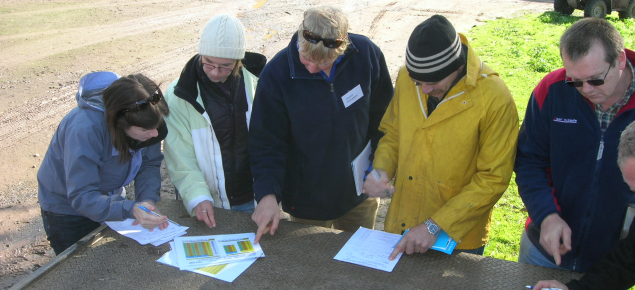What is involved?
The LTEM program runs over one breeding cycle, generally starting around weaning or pre-joining. The timing of each meeting is linked to critical stages in the management of the ewe’s reproductive cycle. All sessions involve a visit to each participant’s farm and focus on condition scoring, pasture assessing and feed budgeting activities that are practical and applicable to the farm business. The program also focuses on improving producer understanding of the influence ewe nutrition has on the performance of the ewe and her progeny.
The LTEM program aids you in developing a successful and productive sheep production system by gaining key skills and knowledge that will help improve your flock's reproductive performance and optimise ewe stocking rates.
LTEM is coordinated by Victorian-based Rural Industry Skills Training (RIST). RIST specialises in providing short course training opportunities to farmers. The course is facilitated by private and government specialists who have been trained in pasture and animal assessment and understand the sheep industry.
The program works!
The program was developed by producers for producers. LTEM has been delivered to about 2000 producers managing about 7.6 million breeding ewes, or almost 20% of the national ewe flock, between 2006/07 and 2013/14. On average, LTEM participants improved the number of lambs weaned per hectare by 30%. This was achieved through a 15% increase in ewe stocking rate, a 50% reduction ewe mortality and a 15% increase in weaning rates.
An independent financial analysis found the benefits from participating in LTEM arise from two avenues (source: John Young, Farming Systems Analysis, Western Australia):
- Increases in efficiency due to improved understanding of the pasture-animal system.
- Adoption of targets for the condition score profile of the ewe flock over the reproduction cycle.
The first avenue for achieving benefits is primarily from improving pasture utilisation and stocking rate. The changes producers make to their systems result from:
- the knowledge gained about animal requirements and pasture growth
- the monitoring of feed-on-offer and animal performance on their farm
- discussions with other producers in the group on how to use this information in their farm system.
The other avenue for achieving benefits relates to having the correct targets for reproducing ewes at key times. This can increase profit, even for producers who are already operating at optimal stocking rates. The benefit of managing ewes to the optimum condition score profile can be up to $5-7 extra profit/ewe for Merino enterprises and $10-12/ewe for prime lamb enterprises.
Changing the condition score profile of the ewes influences profit through its impact on flock productivity and the cost of providing feed. Improving the ewe’s condition score profile will result in:
- decreased ewe mortality
- increased lamb birth weights and lamb survival
- the progeny cutting more wool that is finer.
Key topics covered in the course
- weaning and preparing ewes for next year's joining
- linking ewe condition at joining with lambing potential
- pregnancy management and the impacts of ewe nutrition
- looking forward and planning for lambing — optimising lamb survival and future productivity
- setting up for joining in the second season — manipulating ewe condition and preparing rams
- economic analysis of different feeding strategies.
Getting started
- Get your group together, minimum of five participants, preferably within 50km of each other and happy to work together. If you are having trouble finding five, talk to Brydie Creagh or your prefered trainer for some options.
- Contact Brydie Creagh for a list of active trainers.
- Your trainer will forward your groups details to Rural Industries Skill Training (RIST).
- RIST will be in contact via email and provide a link for online registration and pre-course survey to complete. You will need to supply your Australian Wool Innovation (AWI) Wool Levy Player Registration Number.
- Once all participants have registered, your trainer will start setting up the activities.
For more information on Lifetime Ewe Management and groups in your area, contact Brydie Creagh at the department's Albany office on +61 (0)8 9892 8470 or email bcreagh@rist.edu.au or RIST, Hamilton, Victoria on +61 (0)3 5573 0943 or email info@rist.com.au


